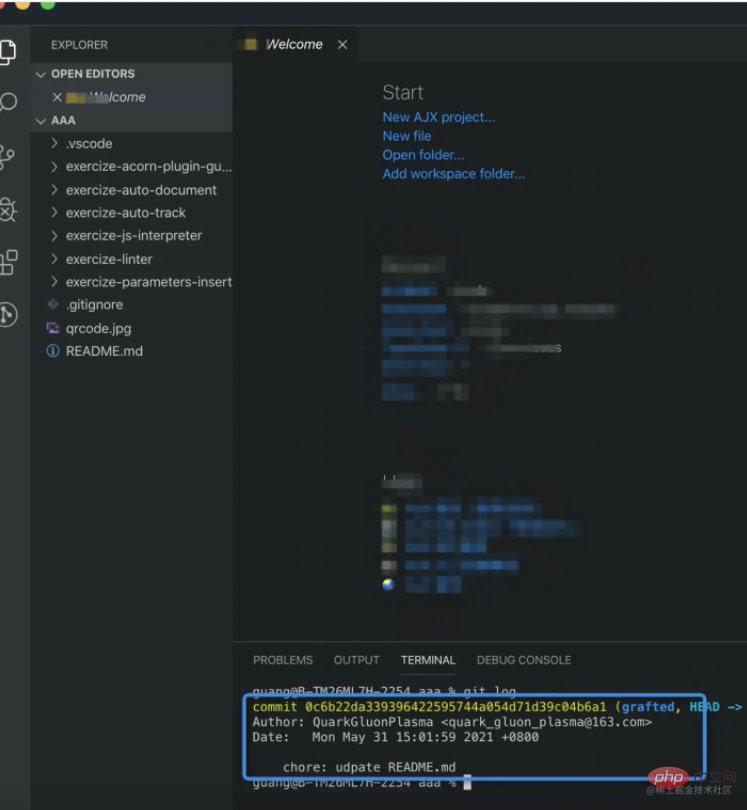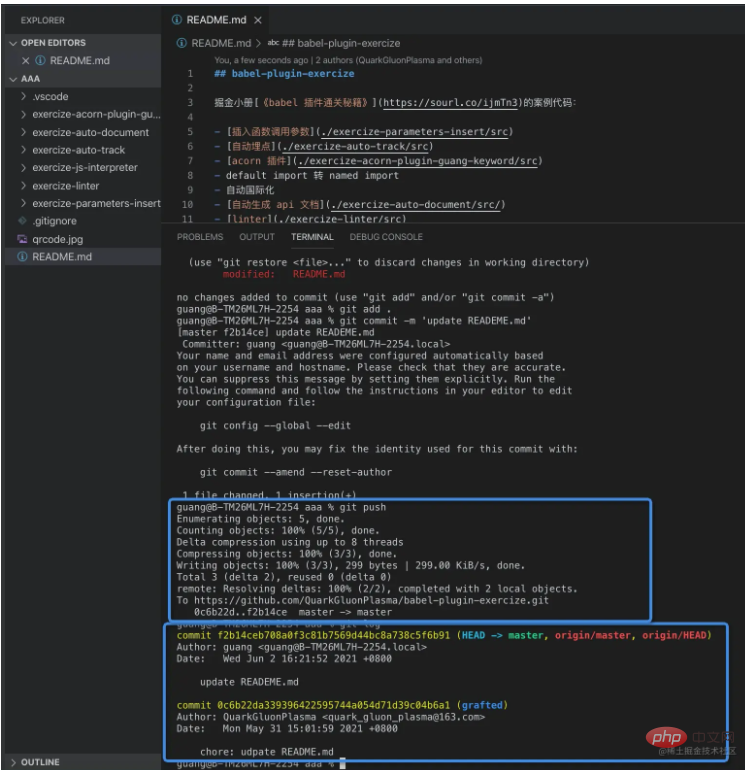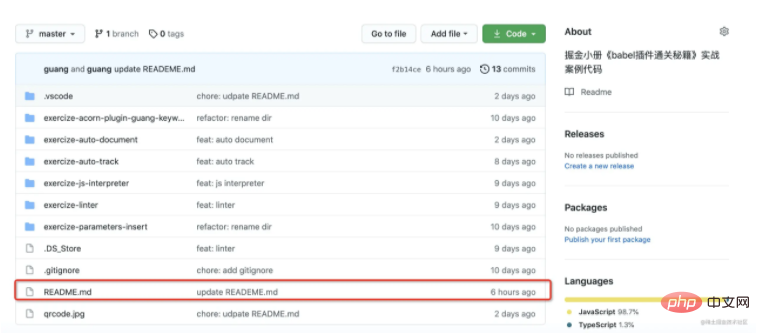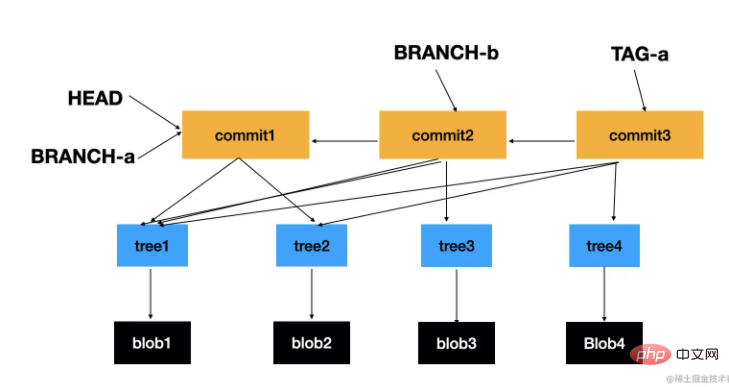Using this technique, git clone can be speeded up dozens of times!
I don’t know if you have encountered larger projects where git clone is very slow or even fails. How will everyone deal with it?
You may consider changing the download source, and you may use some means to increase the Internet speed, but if you have tried all these, it is still relatively slow?
I encountered this problem today. I needed to download the typescript code from gitlab, but the speed was very slow:
git clone https://github.com/microsoft/TypeScript ts
After waiting for a long time, the download was still not completed, so I added a parameter :
git clone https://github.com/microsoft/TypeScript --depth=1 ts
The speed is increased dozens of times, and the download is completed in an instant.
Adding --depth will only download one commit, so the content will be much less and the speed will increase. [Related recommendations: Git usage tutorial]
And the downloaded content can continue to submit new commits and create new branches. It does not affect subsequent development, but you cannot switch to historical commits and historical branches.
I tested it with one of my projects. I first downloaded a commit:

Then made some changes, then git add, commit, push, Can be submitted normally:


Create a new branch and can be submitted normally. The only disadvantage is that you cannot switch to historical commits and historical branches.
It is quite useful in some scenarios: when you need to switch to a historical branch, you can also calculate how many commits are needed, and then specify the depth, which can also improve the speed.
Have you ever thought about why this works?
Git principle
Git saves information through some objects:
- glob object storage file content
- tree object storage file path
- The commit object stores commit information and associates the tree
With one commit as the entry point, all associated trees and blobs are the contents of this commit.

#Commits are related to each other, and head, branch, tag, etc. are pointers to specific commits. It can be seen under .git/refs. In this way, concepts such as branches and tags are implemented based on commit.
Git implements version management and branch switching functions through these three objects. All objects can be seen under .git/objects.
This is the principle of git.
Mainly understand the three objects of blob, tree, and commit, as well as refs such as head, tag, branch, and remote.
The principle of being able to download a single commit
We know that git associates all objects through a certain commit as the entry point, so if we don't need history, we can naturally download only one commit.

#In this way, a new commit is still created based on that commit, and new blobs, trees, etc. are associated. However, the historical commits, trees, and blobs cannot be switched back because they have not been downloaded, nor can the corresponding tag, branch, and other pointers. This is how we download a single commit but can still create new branches, commits, etc.
Summary
When encountering a large git project, you can greatly improve the speed by adding the --depth parameter. The more historical commits, the greater the download speed improvement.
And the downloaded project can still be developed for subsequent development, and new commits, new branches, and tags can be created, but you cannot switch to historical commits, branches, and tags.
We have sorted out the principles of git: files and submission information are stored through the three objects tree, blob, and commit, and functions such as branches and tags are implemented through the association between commits. Commit is the entry point, associated with all trees and blobs.
When we download a commit, we download all its associated trees, blobs, and some refs (including tags, branches, etc.). This is the principle of --depth.
I hope you can use this technique to improve the git clone speed of large projects without switching to historical commits and branches.
The above is the detailed content of Using this technique, git clone can be speeded up dozens of times!. For more information, please follow other related articles on the PHP Chinese website!

Hot AI Tools

Undresser.AI Undress
AI-powered app for creating realistic nude photos

AI Clothes Remover
Online AI tool for removing clothes from photos.

Undress AI Tool
Undress images for free

Clothoff.io
AI clothes remover

Video Face Swap
Swap faces in any video effortlessly with our completely free AI face swap tool!

Hot Article

Hot Tools

Notepad++7.3.1
Easy-to-use and free code editor

SublimeText3 Chinese version
Chinese version, very easy to use

Zend Studio 13.0.1
Powerful PHP integrated development environment

Dreamweaver CS6
Visual web development tools

SublimeText3 Mac version
God-level code editing software (SublimeText3)

Hot Topics
 Git vs. GitHub: Version Control and Code Hosting
Apr 11, 2025 am 11:33 AM
Git vs. GitHub: Version Control and Code Hosting
Apr 11, 2025 am 11:33 AM
Git is a version control system, and GitHub is a Git-based code hosting platform. Git is used to manage code versions and supports local operations; GitHub provides online collaboration tools such as Issue tracking and PullRequest.
 How to update code in git
Apr 17, 2025 pm 04:45 PM
How to update code in git
Apr 17, 2025 pm 04:45 PM
Steps to update git code: Check out code: git clone https://github.com/username/repo.git Get the latest changes: git fetch merge changes: git merge origin/master push changes (optional): git push origin master
 How to download git projects to local
Apr 17, 2025 pm 04:36 PM
How to download git projects to local
Apr 17, 2025 pm 04:36 PM
To download projects locally via Git, follow these steps: Install Git. Navigate to the project directory. cloning the remote repository using the following command: git clone https://github.com/username/repository-name.git
 Is GitHub difficult to learn?
Apr 02, 2025 pm 02:45 PM
Is GitHub difficult to learn?
Apr 02, 2025 pm 02:45 PM
GitHub is not difficult to learn. 1) Master the basic knowledge: GitHub is a Git-based version control system that helps track code changes and collaborative development. 2) Understand core functions: Version control records each submission, supporting local work and remote synchronization. 3) Learn how to use: from creating a repository to push commits, to using branches and pull requests. 4) Solve common problems: such as merge conflicts and forgetting to add files. 5) Optimization practice: Use meaningful submission messages, clean up branches, and manage tasks using the project board. Through practice and community communication, GitHub’s learning curve is not steep.
 How to generate ssh keys in git
Apr 17, 2025 pm 01:36 PM
How to generate ssh keys in git
Apr 17, 2025 pm 01:36 PM
In order to securely connect to a remote Git server, an SSH key containing both public and private keys needs to be generated. The steps to generate an SSH key are as follows: Open the terminal and enter the command ssh-keygen -t rsa -b 4096. Select the key saving location. Enter a password phrase to protect the private key. Copy the public key to the remote server. Save the private key properly because it is the credentials for accessing the account.
 How to use git commit
Apr 17, 2025 pm 03:57 PM
How to use git commit
Apr 17, 2025 pm 03:57 PM
Git Commit is a command that records file changes to a Git repository to save a snapshot of the current state of the project. How to use it is as follows: Add changes to the temporary storage area Write a concise and informative submission message to save and exit the submission message to complete the submission optionally: Add a signature for the submission Use git log to view the submission content
 What to do if the git download is not active
Apr 17, 2025 pm 04:54 PM
What to do if the git download is not active
Apr 17, 2025 pm 04:54 PM
Resolve: When Git download speed is slow, you can take the following steps: Check the network connection and try to switch the connection method. Optimize Git configuration: Increase the POST buffer size (git config --global http.postBuffer 524288000), and reduce the low-speed limit (git config --global http.lowSpeedLimit 1000). Use a Git proxy (such as git-proxy or git-lfs-proxy). Try using a different Git client (such as Sourcetree or Github Desktop). Check for fire protection
 How to merge code in git
Apr 17, 2025 pm 04:39 PM
How to merge code in git
Apr 17, 2025 pm 04:39 PM
Git code merge process: Pull the latest changes to avoid conflicts. Switch to the branch you want to merge. Initiate a merge, specifying the branch to merge. Resolve merge conflicts (if any). Staging and commit merge, providing commit message.






